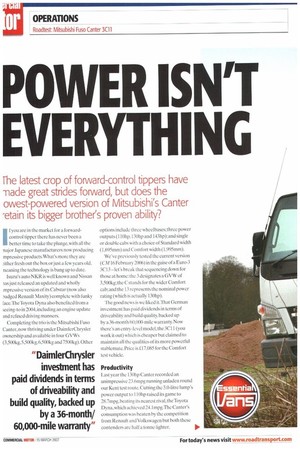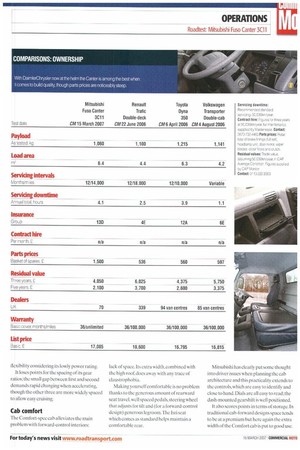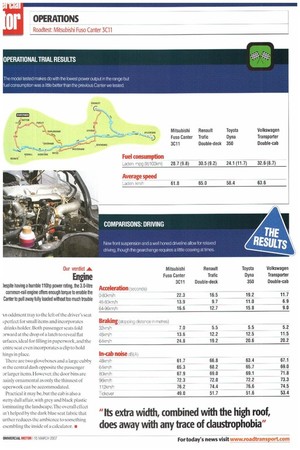POWER ISN'T EVERYTHING
Page 42

Page 44

Page 45

Page 46

If you've noticed an error in this article please click here to report it so we can fix it.
The latest crop of forward-control tippers have made great strides forward, but does the owest-powered version of Mitsubishi's Canter -etain its bigger brother's proven ability?
If you are in the market for a forwardcontrol tipper there has never been a better time to take the plunge, with all the najor Japanese manufacturers now producing mpressive products.What's more they are tither fresh out the box or just a few years old, neaning the technology is bang up to date.
Isuzu's auto NKR is well known and Nissan las just released an updated and wholly mpressive version of its Cabstar (now also padged Renault Maxity) complete with funky face.'lhe Toyota Dyna also benefited from a seeing-to in 2004, including an engine update and refined driving manners.
Completing the trio is the Mitsubishi Fuso Canter, now thriving under DaimlerChrysler ownership and available in four GVWs (3,500kg,5,500kg.6,500kg and 75(X)kg). Other options include three wheelbases; three power outputs (110hp, 130hp and 143hp); and single or double cabs with a choice of Standard width (1,695mm) and Comfort width (1,995mm).
We've previously tested the current version (CM16 February 2()06) in the guise of a Euro-3 3C13 — let's break that sequencing down for those at home: the 3 designates a GVW of 3,500kg; the C stands for the wider Comfort cab; and the 13 represents the nominal power rating (which is actually 130hp).
The good news is we liked it.That German investment has paid dividends in terms of driveability and build quality, backed up by a 36-month/60,000-mile warranty. Now there's an entry-level model, the 3C11 (you work it out) which is cheaper but claimed to maintain all the qualities of its more powerful stablemate. Price is f17.085 for the Comfort test vehicle.
Productivity
Last year the 130hp Canter recorded an unimpressive 23.6rnpg running unladen round our Kent test route. Cutting the 3.0-litre lump's power output to 110hp raised its game to 28.7mpg, beating its nearest rival, the Toyota Dyna, which achieved 24.1m pg.The Canter's consumption was beaten by the competition from Renault and Volkswagen but both these contenders arc half a tonne lighter. The Tipmaster body features a steel floor, aluminium sides and an underfloor electrohydraulic ram. It's solid and easy to use thanks to the sturdy latch arrangement that allows quick dropping of the sidewall, while tipping, via a cab-mounted hand-held control, takes only a few seconds with a commendably smooth action. Maximum payload is 1,060kg; the load area is 6.4m2.
On the road
The driving experience is not generally a major selling point with this class of vehicle; it's usually more a case of keeping it on the straights and guiding it through the bends without causing it to become unsettled. But with a stronger ladder-frame chassis, reinforced cab and revised suspension, the Canter is more capable on the road than you might expect.
A surprising lack of body roll through the cornets allows it to hold a line without the feeling that it might break away; wet weather also fails to detract from its handling.The Canter remains stable at high speeds with the damping effectively taming harsher road surfaces.
The light steering's high ratio demands plenty of wheel twirling, but this works to its advantage as it also provides a tight turning circle — something that the European tipper fraternity can't compete with.
The 3.0-litre engine under the seat offers meaty torque delivery from low-down, enabling the Canter to pull away fully loaded without too much trouble. It is redlined at a rather modest 3.400rpm but pulls effectively up to 3,000rpm, giving more than adequate flexibility considering its lowly power rating.
It loses points for the spacing of its gear ratios; the small gap between first and second demands rapid changing when accelerating, t hough the other three are more widely spaced to allow easy cruising.
Cab comfort
l he Comfort-spec cab alleviates the main i)roblem with forward-control interiors: lack of space. Its extra width,combined with the high roof, does away with any trace of claustrophobia.
Making yourself comfortable is no problem thanks to the generous amount of rearward seat travel, well spaced pedals, steering wheel that adjusts for tilt and (for a forward-control design) generous legroom.The lsri seat which comes as standard helps maintain a comfortable rear. Mitsubishi has clearly put some thought into driver issues when planning the cab architecture and this practicality extends to the controls,which are easy to identify and close to hand. Dials are all easy to read: the dash-mounted gearshift is well positioned.
It also scores points in terms of storage. In traditional cab-forward designs space tends to be at a premium but here again the extra width of the Comfort cab is put to good use. kn oddment tray to the left of the driver's seat perfect for small items and incorporates drinks holder. Both passenger seats fold Drward at the drop of a latch to reveal flat urfaces, ideal for filling in paperwork, and the entre seat even incorporates a clip to hold hings in place.
There are two gloveboxes and a large cubby In the central dash opposite the passenger Dr larger items. However, the door bins are aainly ornamental as only the thinnest of iaperwork can be accommodated.
Practical it may be, but the cab is also a Iretty dull affair, with grey and black plastic lominating the landscape.The overall effect ;n't helped by the dark blue seat fabric that urther reduces the ambience to something esembling the inside of a calculator. •


























































































































































































